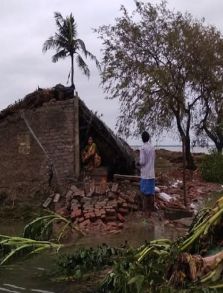
“We have to learn from COVID… We can’t wish away systemic risk. It’s much much cheaper, much more effective to invest upfront in order to avoid disaster and so it is with climate change – a crisis which also involves the entire world and one from which no one can self-isolate.”
Unsustainable growth patterns have exacerbated the risks of climate change in the Asia-Pacific region. The Economic and Social Survey of Asia and the Pacific 2020 highlights that unsustainable consumption and production patterns, associated with the increased use of resources, have contributed to greenhouse gas (GHG) emissions, which in turn affect climate patterns. Hence, unsurprisingly natural disasters are occurring with a higher frequency and intensity. For instance, on 21 May 2020, cyclone Amphan slammed into India’s east coast and neighbouring Bangladesh during COVID-19 pandemic. The loss of casualties was limited, thanks to the multi-hazard early warning systems, which accurately forecast the cyclone and helped in the evacuation of more than three million people.
However, rapidly intensifying storms are becoming a new normal. They are, as scientists suggest, linked to climate change, with studies pointing increasingly to the dangers posed by storms that make a sudden leap in intensity categories. While early warning systems have been helpful in saving lives through timely evacuation of at-risk communities before cyclones strike, the increasing economic impact of such events is a cause of grave concern. For instance, the economic impact of Amphan is estimated at $13 billion and $135 million in India and Bangladesh, respectively. The damages mostly relate to social infrastructure (housing, schools, and hospitals), physical infrastructure (energy, transport, water/sanitation, ICT) and agriculture (crops, livestock).
Why are the costs of climate change rising? Because of the exposure of critical infrastructure in high-risk areas. The Asia-Pacific Disaster Report 2019 has highlighted that high proportions of the existing critical infrastructures are located in multi-hazard risk hotspots, which when the natural disasters occur, lead to a significant disruption in economic activity. For instance, a third of energy power plants, ICT fibre-optic cables, and airports and over 42 per cent of road infrastructure are located in multi-hazard risk hotspots.
How can resilience be built in defending against climate change? This requires both monetary investments and policy actions. Building infrastructure that is climate-resilient (adaptation) and reducing the release of GHG emissions (mitigation) are two keys aspects, which can be strengthened through a coalition of stakeholders to move towards a low-carbon world.
- Enhancing climate change adaptation ex-ante. We should reduce our vulnerability to climate change, especially in risk hotspots, by building infrastructure that is resilient to climate change. ESCAP estimates suggest that an additional investment of $182 billion per year is needed to include resilience against increasing forces of nature into the design and construction of transport, ICT and water and sanitation infrastructures.
- Investing in climate change mitigation. Reducing the release of GHG emissions that are warming our planet requires a reduction in the reliance on fossil fuels and largely improving energy efficiency. This would require an annual additional investment of $191 billion.
- Building a coalition of stakeholders. To move towards a low-carbon world, the Decade of Action calls for action at local, people, and global level. In this vein, the ESCAP 2020 Survey highlighted the following actions:
- Local – Governments should lead the transition out of fossil fuel by removing fossil fuel subsidies, introducing carbon pricing throughemissions trading schemes or a carbon tax, and greening the financial systems by providing financial and regulatory incentives to encourage transparency in emissions and green investments.
- People – Businesses should internalize such negative social and environmental externalities caused by their operations, by incorporating environmental, social and governance factors into their business decisions;consumers on their own should choose sustainable lifestyles. For instance, they can choose public transport or opt for energy-efficient home appliances to reduce their own carbon footprints.
- Global (regional) – Cross-border cooperation is crucial to prevent inaction and raise our ambitions on climate-related goals. For instance, in terms of mitigation, countries can accelerate the pace towards decarbonization by developing regional carbon markets. Additionally, countries should cooperate to increase resilience through adaptation. In this respect, Japan has led the Group of 20 Action Agenda on Adaptation and Resilient Infrastructure, while the Government of India has led the launch of the Coalition for Disaster Resilient Infrastructure.
As we are fighting with COVID-19, dealing with climate change seems like a luxury to only afford in future. However, time, tide, and climate change wait for no man. A sombre lesson from the pandemic is that long-term benefits should never be sacrificed for short term gains and that it is almost impossible to isolate oneself from a global shock. Hence, it’s time to move towards the development approach that prioritizes people and the planet.


